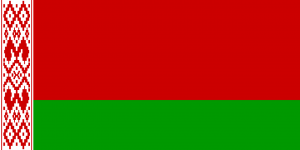Language/Belarusian/Grammar/Adjectives
Hi Belarusian learners! 😊
In this lesson, we will be exploring adjectives in Belarusian. Adjectives are a crucial part of speech as they describe and provide more information about a noun. We will learn how to use adjectives correctly and how they are formed in the Belarusian language.
Consider broadening your understanding by checking out these related lessons: Prepositions, Gender, Adverbs & Comparatives.
Introduction to Adjectives[edit | edit source]
Adjectives are words that describe or modify a noun. They usually provide more information about the size, color, shape, or number of the noun. In Belarusian, most adjectives come before the noun they describe, but some can follow it.
Here are some examples of adjectives in Belarusian:
| Belarusian | Pronunciation | English |
|---|---|---|
| вялікі | vyaliki | big |
| красівы | krasivy | beautiful |
| добры | dobry | good |
| новы | novy | new |
In the above examples, вялікі (vyaliki) describes the size of the noun, красівы (krasivy) describes its appearance, добры (dobry) describes the quality, and новы (novy) describes the time or age of the noun.
Formation of Adjectives[edit | edit source]
Most adjectives in Belarusian are formed by adding a suffix to a noun. The most common suffixes are -скі (ski), -чны (chny), and -вы (vy).
For example:
| Belarusian Noun | Adjective Formed with -скі | Adjective Formed with -чны | Adjective Formed with -вы |
|---|---|---|---|
| вокны (vokny) - window | вокнаўскі (voknauskі) - window (adj.) | вокнычны (voknychy) - window (adj.) | вокнывы (voknyvy) - window (adj.) |
| дом (dom) - house | дамоўскі (damouski) - house (adj.) | домчны (domchny) - house (adj.) | домавы (domavy) - house (adj.) |
In the above example, we see how the suffixes -скі, -чны, and -вы are added to the Belarusian nouns вокны (vokny) and дом (dom) to form adjectives.
There are also some irregular adjectives that do not follow any set rules. They must be learned individually.
Here are some examples of adjectives and their irregular forms:
| Belarusian | Pronunciation | English |
|---|---|---|
| добры | dobry | good |
| малады | malady | young |
| вялікі | vyaliki | big |
| высокі | vysoki | tall |
| сіні | sini | blue |
Plural Adjectives[edit | edit source]
In Belarusian, adjectives agree in gender and number with the noun they describe. If the noun is singular, then the adjective is also in the singular form. If the noun is plural, then the adjective must be in the plural form as well.
To form a plural adjective, we simply add the suffix -ыя (-yya) to the singular form of the adjective.
Here are some examples of singular and plural adjectives in Belarusian:
| Belarusian | Singular Adjective | Plural Adjective |
|---|---|---|
| добры | dobry | добрыя (dobryya) |
| малады | malady | маладыя (maladyya) |
| вялікі | vyaliki | вялікія (vyalikiya) |
| сіні | sini | сінія (siniya) |
Comparison of Adjectives[edit | edit source]
In Belarusian, adjectives also have three degrees of comparison: positive, comparative, and superlative.
Here are some examples of how comparison works in Belarusian:
- Positive degree: добры (dobry) - good
- Comparative degree: лепшы (lepshy) - better
- Superlative degree: самы добры (samy dobry) - the best
To form the comparative degree of an adjective, add the suffix -ейшы (-eishy) to the end of the stem of the adjective.
To form the superlative degree of an adjective, add the word самы (samy) before the comparative degree.
Here is an example:
- Positive degree: вялікі (vyaliki) - big
- Comparative degree: больш вялікі (bolsh vyaliki) - bigger
- Superlative degree: самы вялікі (samy vyaliki) - the biggest
Dialogue[edit | edit source]
Here is a dialogue between two friends, Natasha and Alex, who are discussing their favorite colors:
- Natasha: Мой любімы колер зялёны. (Moy lyubimy koler zyalony) - My favorite color is green.
- Alex: А мой любімы колер жоўты. (A moy lyubimy koler zhoŭty) - And my favorite color is yellow.
- Natasha: Які прыклад змянення для асноўнага колеру зялёны? (Yaki pryklad zmianennia dlia asnouhnaaha koleru zyalony?) - What is an example of changing the basic color green?
- Alex: Ад зялёнага да тэмна-зялёнага. (Ad zyalonaha da temna-zyalonyaha) - From green to dark green.
Conclusion[edit | edit source]
In conclusion, adjectives are a crucial part of Belarusian grammar, as they help describe and provide more details about a noun. Adjectives can be formed by adding suffixes to nouns and change with the number and gender of the noun. They also have a comparative and superlative degree, which can be useful for making comparisons.
To improve your Belarusian Grammar, you can also use the Polyglot Club website. Find native speakers and ask them any questions!
➡ If you have any questions, please ask them in the comments section below.
➡ Feel free to edit this wiki page if you think it can be improved. 😎
Now that you've completed this lesson, don't stop learning! Check out these related topics: Belarusian Grammar: Nouns and Cases, Belarusian Grammar: Verbs: Past Tense, Personal Pronouns & Prepositional Case.
Other Lessons[edit | edit source]
- Personal Pronouns
- Prepositions
- Nouns
- Future Tense
- Pronouns
- Adverbs
- Gender
- Possession
- Conditional Mood
Sources[edit | edit source]

